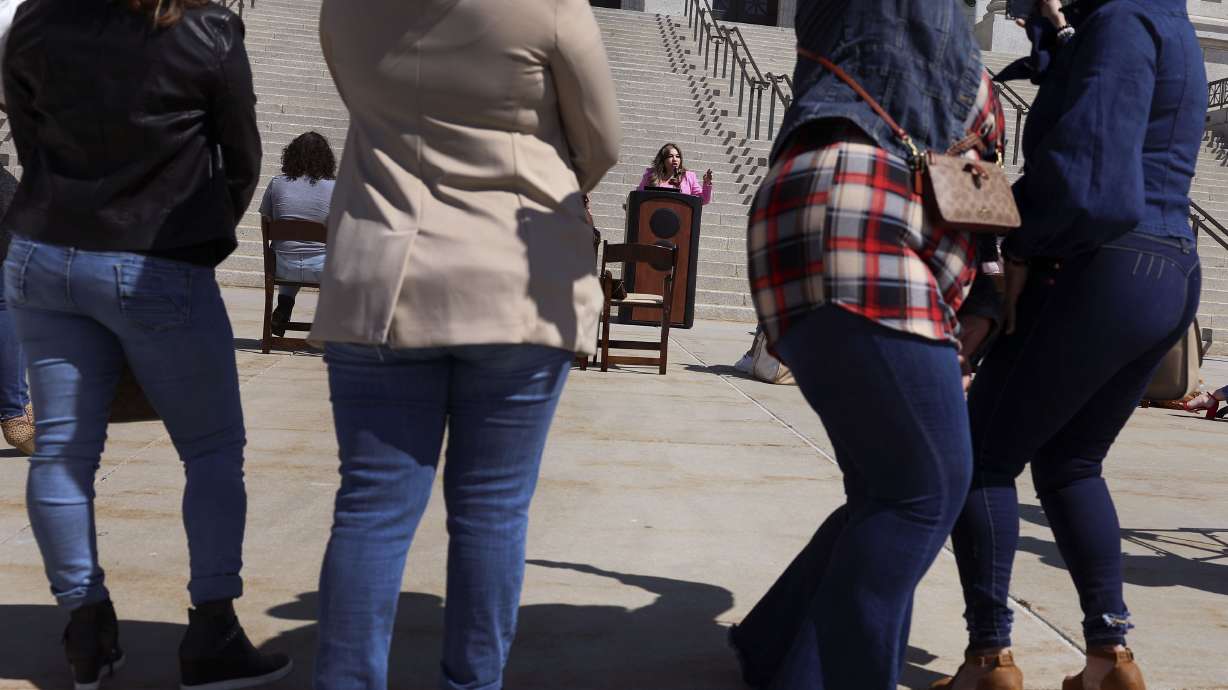Estimated read time: 4-5 minutes
This archived news story is available only for your personal, non-commercial use. Information in the story may be outdated or superseded by additional information. Reading or replaying the story in its archived form does not constitute a republication of the story.
SALT LAKE CITY — The last Wednesday of April is reserved for denim — to recognize survivors of sexual violence.
Denim Day is the longest-running sexual violence prevention and education campaign in history, with origins dating back to 1999, after the Italian Supreme Court overturned a conviction in a high-profile rape trial. The court reasoned that a victim who was wearing "tight" jeans must've consented or aided in their removal. After the court's decision, members of the Italian parliament wore jeans to protest the decision.
Wearing jeans on Denim Day has become an international symbol of protest against victim-shaming and blaming in cases of sexual assault and violence.

On Wednesday, citizens from all over Utah, including sexual assault survivors and advocates with the Utah Coalition Against Sexual Assault, gathered on the steps at the Utah Capitol, in solidarity with men and women who also donned denim all over the world.
"Denim Day, in particular, is a day that was based off of this concept of victim-blaming, right? And it's all too common of a phenomenon for survivors to go through. There is a reason that sexual assault is the most underreported crime — and too many survivors have seen other people not be believed before them," said Emily Bernath, a sexual assault survivor.
"I lost a lot of friends because I didn't want to be in a space full of people that didn't support me," she said. "So, not only was it painful — emotionally and physically — but it was also painful relationally, because it was a very isolating experience."
How prevalent is sexual violence?
Utah has continually struggled with rates of sexual violence higher than the national average, according to Utah Department of Health data. Rape is also the only violent crime for which Utah ranks higher than the national average.
"There is no excuse for sexual assaults," said Jorge Barraza, program manager for the Utah Coalition Against Sexual Assault. "Sexual assault is the most underreported violent crime, and that reality will not change until a world creates safe spaces where survivors are supported, encouraged and believed."
"I think it's time that we kind of look at the mirror and see what are we doing that's causing this and what can we do to end this," he said.
In Utah, 1 in 5 women and 1 in 25 men experience rape or attempted rape during their lifetime, the data indicates. Additionally, nearly 1 in 3 women will experience some form of sexual violence in their lives.
"We, as a state, could end sexual assault if we chose to do so," said Barraza. "We just need everybody to decide we're going to do this. And doing so begins with me and with you.
"As a member of your community, as a parent, as an educator, as a religious leader, as a lawmaker — you play a part in ending sexual violence because it takes all of us to create a healthy community."
Education and prevention
So how do we move forward? Advocates and survivors pointed to education and prevention.
"Primary prevention is not self-defense. Primary prevention is not telling people to carry Mace. Primary prevention is people not needing to know martial arts or self-defense in order to feel safe in our community. You should be able to walk down any street of any town, at anytime, day or night, without the threat of violence against you," said Barraza.
We need to educate kids, all of us, on consent and what's normal and what's not.
– Codee Barker, student
What does sexual violence prevention look like? The solutions are complex, notes the U.S. Centers for Diseases Control and Prevention. Prevention of sexual violence requires understanding and addressing risk and protective factors at the individual, relational, community and societal levels.
The CDC offers a resource titled "STOP" to aid in prevention education:
- Social norms — promote norms that protect against violence such as bystander approaches and mobilizing men and boys as allies.
- Teach Skills to Prevent Sexual Violence — Social-emotional learning, teaching healthy, safe dating and intimate relationship skills to adolescents, promoting healthy sexuality and empowerment-based training.
- Offer opportunities to Empower and Support Girls and Women — strengthening economic support for women and families, strengthening leadership and opportunities for girls.
- Protective Environments — Improving safety and monitoring in schools, establishing and consistently applying workplace policies, and addressing community-level risks through environmental approaches.
"We need to educate kids, all of us, on consent and what's normal and what's not. I think society has a lot to do with that and I sincerely do believe that as youth and as a society, we've become numb to physical touch and a lack of consent," said Utah high school student Codee Barker. "Bring attention to everyone, not just to us, not just the parents, not just boys and girls. We need to come together to solve this problem because it's universal and it's been happening for way too long."
Sexual Violence Resources
Help for people who've experienced sexual violence or need to access resources for a loved one can be found here:
Utah Coalition Against Sexual Assault 24-hour crisis line: 801-736-4356
Utah Coalition Against Sexual Assault Spanish 24-hour crisis line: La Coalición de Utah Contra la Agresión Sexual cuenta con una línea de ayuda de habla hispana contra la agresión sexual 801-924-0860.
Utah Office for Victims of Crime: 1-801-238-2360
Utah Children's Justice Center: 801-281-1228
Rape, Abuse, Incest National Network: 1-800-656-4673
To find your nearest community-based resource center visit ucasa.org/community










